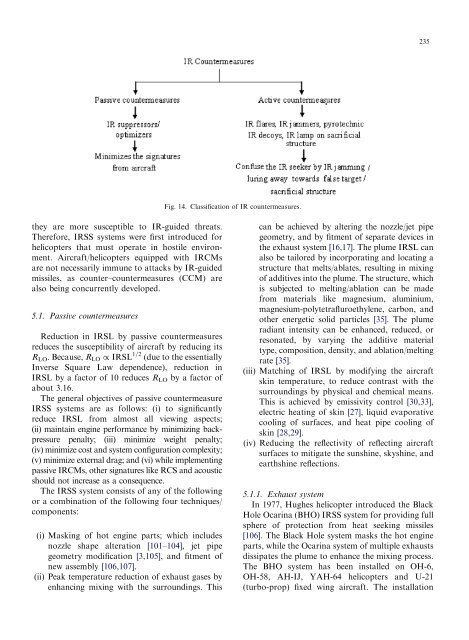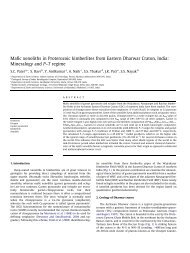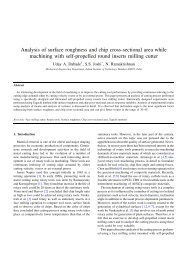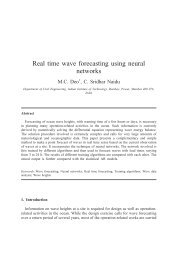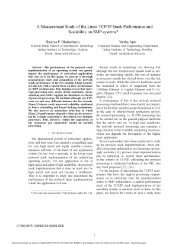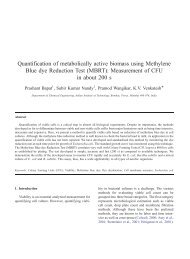Infrared signature studies of aerospace vehicles - DSpace at IIT ...
Infrared signature studies of aerospace vehicles - DSpace at IIT ...
Infrared signature studies of aerospace vehicles - DSpace at IIT ...
You also want an ePaper? Increase the reach of your titles
YUMPU automatically turns print PDFs into web optimized ePapers that Google loves.
they are more susceptible to IR-guided thre<strong>at</strong>s.<br />
Therefore, IRSS systems were first introduced for<br />
helicopters th<strong>at</strong> must oper<strong>at</strong>e in hostile environment.<br />
Aircraft/helicopters equipped with IRCMs<br />
are not necessarily immune to <strong>at</strong>tacks by IR-guided<br />
missiles, as counter–countermeasures (CCM) are<br />
also being concurrently developed.<br />
5.1. Passive countermeasures<br />
Reduction in IRSL by passive countermeasures<br />
reduces the susceptibility <strong>of</strong> aircraft by reducing its<br />
RLO. Because, RLO / IRSL 1=2 (due to the essentially<br />
Inverse Square Law dependence), reduction in<br />
IRSL by a factor <strong>of</strong> 10 reduces RLO by a factor <strong>of</strong><br />
about 3.16.<br />
The general objectives <strong>of</strong> passive countermeasure<br />
IRSS systems are as follows: (i) to significantly<br />
reduce IRSL from almost all viewing aspects;<br />
(ii) maintain engine performance by minimizing backpressure<br />
penalty; (iii) minimize weight penalty;<br />
(iv) minimize cost and system configur<strong>at</strong>ion complexity;<br />
(v) minimize external drag; and (vi) while implementing<br />
passive IRCMs, other <strong>sign<strong>at</strong>ure</strong>s like RCS and acoustic<br />
should not increase as a consequence.<br />
The IRSS system consists <strong>of</strong> any <strong>of</strong> the following<br />
or a combin<strong>at</strong>ion <strong>of</strong> the following four techniques/<br />
components:<br />
(i) Masking <strong>of</strong> hot engine parts; which includes<br />
nozzle shape alter<strong>at</strong>ion [101–104], jet pipe<br />
geometry modific<strong>at</strong>ion [3,105], and fitment <strong>of</strong><br />
new assembly [106,107].<br />
(ii) Peak temper<strong>at</strong>ure reduction <strong>of</strong> exhaust gases by<br />
enhancing mixing with the surroundings. This<br />
ARTICLE IN PRESS<br />
Fig. 14. Classific<strong>at</strong>ion <strong>of</strong> IR countermeasures.<br />
235<br />
can be achieved by altering the nozzle/jet pipe<br />
geometry, and by fitment <strong>of</strong> separ<strong>at</strong>e devices in<br />
the exhaust system [16,17]. TheplumeIRSLcan<br />
also be tailored by incorpor<strong>at</strong>ing and loc<strong>at</strong>ing a<br />
structure th<strong>at</strong> melts/abl<strong>at</strong>es, resulting in mixing<br />
<strong>of</strong> additives into the plume. The structure, which<br />
is subjected to melting/abl<strong>at</strong>ion can be made<br />
from m<strong>at</strong>erials like magnesium, aluminium,<br />
magnesium-polytetrafluroethylene, carbon, and<br />
other energetic solid particles [35]. The plume<br />
radiant intensity can be enhanced, reduced, or<br />
reson<strong>at</strong>ed, by varying the additive m<strong>at</strong>erial<br />
type, composition, density, and abl<strong>at</strong>ion/melting<br />
r<strong>at</strong>e [35].<br />
(iii) M<strong>at</strong>ching <strong>of</strong> IRSL by modifying the aircraft<br />
skin temper<strong>at</strong>ure, to reduce contrast with the<br />
surroundings by physical and chemical means.<br />
This is achieved by emissivity control [30,33],<br />
electric he<strong>at</strong>ing <strong>of</strong> skin [27], liquid evapor<strong>at</strong>ive<br />
cooling <strong>of</strong> surfaces, and he<strong>at</strong> pipe cooling <strong>of</strong><br />
skin [28,29].<br />
(iv) Reducing the reflectivity <strong>of</strong> reflecting aircraft<br />
surfaces to mitig<strong>at</strong>e the sunshine, skyshine, and<br />
earthshine reflections.<br />
5.1.1. Exhaust system<br />
In 1977, Hughes helicopter introduced the Black<br />
Hole Ocarina (BHO) IRSS system for providing full<br />
sphere <strong>of</strong> protection from he<strong>at</strong> seeking missiles<br />
[106]. The Black Hole system masks the hot engine<br />
parts, while the Ocarina system <strong>of</strong> multiple exhausts<br />
dissip<strong>at</strong>es the plume to enhance the mixing process.<br />
The BHO system has been installed on OH-6,<br />
OH-58, AH-IJ, YAH-64 helicopters and U-21<br />
(turbo-prop) fixed wing aircraft. The install<strong>at</strong>ion


